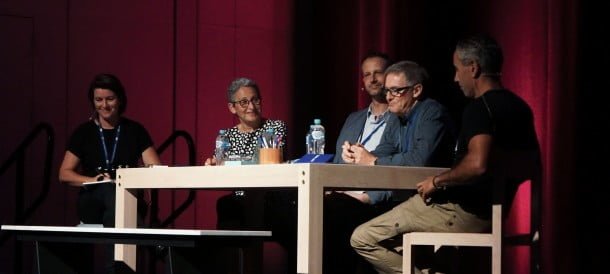Lee Hillam finds herself inspired by How Soon is Now – and Julie Eizenberg’s ‘fierce’ comment.
Who went to the recent How Soon is Now conference? I did, and so did many other women. Looking around the crowd it was great to see a balance of genders. It felt more like normal society and less like the crowd at a boys’ school 25-year reunion. There were lots of women – perhaps not half, but lots. The creative directors and at least two of the speakers had their babies there. And the speakers were representative of society, perhaps even more than the crowd. There was diversity in age and ethnicity as well as an equitable number of men and women. So this is all good news. The most positive aspect of all this, for me, was how normal it felt. I was not gob-smacked by the number of women in the crowd and on the stage. In fact, I had to do a tally in the margins of the program to work out that actually there were slightly MORE women than men as speakers.
The push from the Institute and from the industry in general towards an equitable industry is showing clearly in the conference, and this will undoubtedly have an effect – just as you could say that the line-up at the conference has been influenced by the Institute’s two- and-a half-year-old Gender Equity Policy, which itself could be said to have gestated out of the ARC-funded study ‘Equity and Diversity in the Australian Architecture Profession: Women, Work and Leadership’. This study also gave birth to Parlour. (I’m loving the female-focused fertility metaphors, sorry!)
I found the conference itself very thought-provoking and more stimulating and optimistic than I was expecting. There may have been those who missed the overwhelming flood of pretty images usually associated with conferences, but not me. What was inspiring was to see this discussion around all the things that architecture is – before and after it is a pretty image. The long journeys through planning, policy and political change, the ways architects are useful beyond the design of objects and into advocacy, engagement, education and social change. But I digress.
What I actually wanted to talk about was one comment by one speaker, perhaps given flippantly, but which has been bouncing around my head ever since. Julie Eizenberg, when asked how she has dealt with issues of gender inequity in her career, said:
Act as if it isn’t there, but know that it is there. Because if you act as if it is there, you are coming from a position of weakness and you can’t do that. You must be fierce.
Even reading it again I have to pause. Act as if it isn’t there? Surely not!
But then, I realised that this makes a lot of sense and it aligns with something I’ve always believed – if you want people to be trustworthy you have to trust them first. So, when we are dealing with situations in which we are potentially going to experience the downsides of the inequitable world we live in, we should not assume that we will be overlooked and downtrodden, we should assume the opposite. We should give all those male developer clients, bosses and consultants the opportunity to put their best self forward, rather than allowing them to behave badly by setting low expectations of them. This strategy is an important piece in the game they call ‘managing up’.
And the second part of her comment? That if we accept the status quo of inequity, then we are placing ourselves in a position of weakness. I agree absolutely. I do not accept it. In fact, it does not exist. Men and women architects are not unequal, so I refuse to behave in any way that might reinforce the false belief of those who think they are. Women architects are, at this point in time, unequally treated, and that is what we’re all working to change. But it won’t help to accept the circumstances while moaning and complaining about how unfair it is. It is more useful to be fierce, as Julie says. So there are few women leaders in architecture? Well then, let us be leaders and show everyone how it is done. Sheryl Sandberg said it another way when she urged us to ‘lean in’, which is a polite way of saying the same thing as ‘You must be fierce’.
All that said, this advice doesn’t apply to all people in our industry. If you are in a leadership position yourself, you can no longer ‘act as if it isn’t there’, because your obligation is to lead, not to manipulate by the political and psychological tactics that the rest of us must resort to. The Institute and the creative leaders of the last few conferences are leading. The directors involved in the Male Champions of Change program are leading.
And this brings me back to why I really enjoyed the How Soon Is Now conference. For all the time I’ve spent ruminating on that one thing Julie Eizenberg said, there were countless others that set my brain whirring. The topics and the speakers were outside of my daily practice, but highly complementary to it, and looking around the crowd I felt optimistic for the future of the profession.
Lee Hillam is the Chair of the National Committee for Gender Equity (NCGE) and a director of Sydney-based Dunn & Hillam Architects. She has taught at the University of NSW and the University of Sydney in the School of Architecture.





















